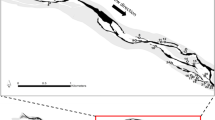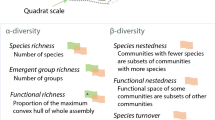Abstract
The sedentary fauna of sublittoral boulders was studied at five sites with very different environmental conditions within Lough Hyne Marine Nature Reserve (51° 30′ N, 9° 18′ W). The degree of competition was assessed through the construction of competitive hierarchies built up from the results of nearly 3000 interactions between organisms. Communities at all sites were predominantly hierarchically organised with few stand-offs recorded. Density of interactions was correlated with total space occupation. Flow speed at all sites was logged over 24 h and this factor also correlated with space occupation. Degree of disturbance was assessed through the use of marked boulders at each site. Species diversity peaked where all factors were ‘moderate’ and was lowest at ‘extreme’ sites. The effects of these environmental variables and biotic factors in determining community composition are discussed, and a working model detailing a ‘Minimum Stress Inflexion’ is described. This represents an extension of the intermediate disturbance hypothesis in that it is proposed that disturbance in this system may serve to reduce sediment load as opposed to preventing space monopolisation in the classical model.
Similar content being viewed by others
References
Airoldi, A., 1998. Roles of disturbance, sediment stress, and substratum retention on spatial dominance in algal turf. Ecology 79: 2759–2770.
Barnes, D. K. A. & A. Clarke, 1999. The ecology of an assemblage dominant: the encrusting bryozoan Fenestrulina rugula. Invert. Biol. 117: 331–340.
Bassindale, R., F. J. Ebling, J. A. Kitching & R. D. Purchon, 1948. The ecology of the Lough Ine rapids with special reference to water currents. I. Introduction and hydrography. J. Ecol. 36: 305–322.
Benedetti-Cecchi, L., L. Airoldi, M. Abbiati & F. Cinnelli, 1996. Estimating the abundance of benthic invertebrates: a comparison of procedures and variability between observers. Mar. Ecol. Prog. Ser. 138: 93–101.
Connell, J., 1961. Effect of competition, predation by Thais lapillus, and other factors on natural populations of the barnacle Balanus balanoides. Ecol. Monogr. 31: 61–104.
Elner, R. W. & R. L. Vadas, 1990. Inference in ecology: the Sea urchin phenomenon in the northwestern Atlantic. Am. Nat. 136: 108–125.
Hiscock, K., 1983. Water movement. In Earll, R. & D. G. Erwin (eds), Sublittoral Ecology: The Ecology Of The Shallow Sublittoral Benthos. Clarendon Press, Oxford: 58–96.
Huston, M., 1979. A general hypothesis of species diversity. Am. Nat. 113: 81–101.
Hutchinson, G. E., 1959. Homage to Santa Rosalia, or why are there so many different kinds of animals? Am. Nat. 93: 145–159.
Hutchinson, G. E., 1961. The paradox of the plankton. Am. Nat. 95: 137–145.
Jackson, J. B. C., 1979. Overgrowth competition between encrusting cheilostome ectoprocts in a Jamaican cryptic reef environment. J. anim. Ecol. 48: 805–823.
Karlson, R. H. & J. B. C. Jackson, 1981. Competitive networks and community structure: a simulation study. Ecology 62: 670–678.
Kitching, J. A. & F. J. Ebling, 1967. Ecological studies at Lough Ine. Adv. ecol. Res. 4: 197–291.
Knowlton, N. & J. B. C. Jackson, 1994. New taxonomy and niche partitioning on coral reefs: Jack of all trades or master of some? Trend. Ecol. Evol. 9: 7–9.
Lilly, S. J., J. F. Sloane, R. Bassindale, F. J. Ebling & J. A. Kitching, 1953. The ecology of the Lough Ine rapids with special reference to water currents. IV. The sedentary fauna of sublittoral boulders. J. anim. Ecol. 22: 87–122.
MacArthur, R. H. & R. Levins, 1967. The limiting similarity, convergence and divergence of coexisting species. Am. Nat. 101: 377–385.
Maughan, B. C., 2000. Ecology of encrusting epifauna in Lough Hyne Marine Nature Reserve, Co. Cork, Ireland. Unpubl. Ph. D thesis, University College Cork, Ireland: 154 pp.
McGuinness, K., 1987. Disturbance and organisms on boulders. II. Causes of patterns in diversity and abundance. Oecologia 71: 420–430.
McGuinness, K., 1990. Physical variability, diversity gradients and the ecology of temperate and tropical reefs. Aust. J. Ecol. 15: 465–476.
Menge, B. A. & J. P. Sutherland, 1987. Community regulation: variation in disturbance, competition and predation in relation to environmental stress and recruitment. Am. Nat. 130: 730–757.
Nandakumar, K., 1995. Competitive interactions among sessile organisms in Tomioka Bay, South Japan: importance of light conditions on the panel surface. Mar. Biol. 121: 713–719.
Paine, R. T., 1979. Disaster, catastrophe and local persistence of the sea palm Postelsia palmaeformis. Science 205: 685–687.
Paine, R. T., 1974. Intertidal community structure: experimental studies on the relationship between a dominant competitor and its principal predator. Oecologia 15: 93–120.
Pickett, S. T. A., J. Kolasa, J. J. Armesto & S. L. Collins,1989. The ecological concept of disturbance and its expression at various hierarchical levels. Oikos 54: 129–136.
Quinn, J. F., 1982. Competitive hierarchies in marine benthic communities. Oecologia 53: 12–19.
Rogers, C. S., 1990. Responses of coral reefs and reef organisms to sedimentation. Mar. Ecol. Prog. Ser. 62: 185–202.
Rubin, J. A., 1982. The degree of intransitivity and its measurement in an assemblage of encrusting cheilostome bryozoa. J. exp. mar. Biol. Ecol. 60: 119–128.
Russ, G. R., 1982. Overgrowth in a marine epifaunal community: competitive hierarchies and competitive networks. Oecologia 53: 12–19.
Saiz-Salinas, J. I. & I. Urdangarin, 1994. Response of sublittoral hard substrate invertebrates to estuarine sedimentation in the outer harbour of Bilbao (N. Spain). Mar. Ecol. 15: 105–131.
Sebens, K. P., 1986. Spatial relationships among encrusting marine organisms in the New England subtidal zone. Ecol. Monogr. 56: 73–96.
Sousa, W. P., 1979. Disturbance in Marine intertidal boulder fields: the non-equilibrium maintenance of species diversity. Ecology 60: 1225–1239.
Tanaka, M. & K. Nandakumar, 1994. Measurement of the degree of intransitivity in a community of sessile organisms. J. exp. mar. Biol. Ecol. 182: 85–95.
Turner, S. J. & C. D. Todd, 1994. Competition for space in encrusting bryozoan assemblages: The influence of encounter angle, site and year. J. mar. biol. Ass. U. K. 74: 603–622.
Umar, M. J., L. J. McCook & I. R. Price, 1998. Effects of sediment deposition on the seaweed Sargassum on a fringing coral reef. Coral Reefs 17: 169–177.
Underwood, A. J. & P. G. Fairweather, 1989. Supply-side ecology and benthic marine assemblages. Trends Ecol. Evol. 4: 16–20.
Underwood, A. J. & P. G. Fairweather, 1985. Intertidal communities: do they have different ecologies or different ecologists? Proc. Ecol. Soc. Aust. 14: 7–16.
Warner, G. F., 1984. Dynamic stability in two contrasting epibenthic communities. In Gibbs, P. E. (ed.), Proceedings of the 19th European Marine Biology Symposium. Cambridge University Press: 401–410.
Rights and permissions
About this article
Cite this article
Maughan, B.C., Barnes, D.K.A. A ‘minimum stress inflexion’ in relation to environmental and biotic influences on the dynamics of subtidal encrusting communities?. Hydrobiologia 440, 101–109 (2000). https://doi.org/10.1023/A:1004134103670
Issue Date:
DOI: https://doi.org/10.1023/A:1004134103670




